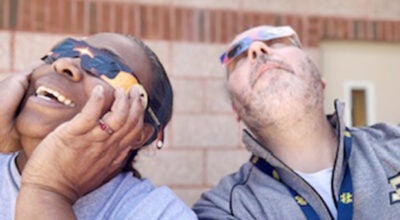Boy Scouts: 100 years and counting
Published 11:00 pm Friday, May 7, 2010
By JOHN EBY
Niles Daily Star
DOWAGIAC – Six Eagle Scouts attended Jim Ellis’ series-ending lecture on “100 Years of the Boy Scouts: 1910-2010” Wednesday night at The Museum at Southwestern Michigan College.
Those of the most exalted rank, representing the most accomplished 2 percent of all Scouts, included Tim Pitcher of Sister Lakes, Ellis’ collaborator Chris Patton of Buchanan, Mike McCake, of Dowagiac, who provided a centennial cake, Dick Judd, of Dowagiac, Mike Daron, of Dowagiac and Loren J. Riddle, of Niles.
Coincidentally, Ellis, who is writing a book on Camp Madron near Buchanan, said that is the same number of countries Boy Scouting’s first century has not penetrated – the People’s Republic of China; Andorra, between France and Spain; Cuba; North Korea; Laos; and Myanmar.
Ellis said Dowagiac once boasted its own council (today it falls under the umbrella of the LaSalle Council in South Bend, along with Berrien and eight northern Indiana counties.
The Jamboree is coming up May 15 at the St. Joseph County (Ind.) Fairgrounds and is being overseen by Bart Comstock.
Ellis has been in Scouting for half of that century, from camping in the 1960s to being on staff in the 1970s.
He said he narrated the Indian pageant, but was not a dancer.
Boy Scouting, started in Britain by Lord Robert Baden-Powell (1857-1941) and incorporated in the United States by W.D. Boyce, “is alive and well – despite what’s been reported in many newspapers,” said Ellis, who teaches at Lake Michigan College near Benton Harbor.
The international organization claims 28 million members in 160 nations.
There are 26 “territories” which may not have their own Scouting organization, but there is some affiliated organization. Its main headquarters are in Irving, Texas.
There are 29 countries where Scouting exists, but they do not belong to the world organization.
The United States is second to Indonesia’s 8,103,385 Scouts, down to 61 in Monaco.
Ellis also disputed that to say Scouting is not in China is “misleading” because Hong Kong has it.
Sightseeing in Tunisia, Ellis encountered a Scout troop whose English was better than his French or Arabic, so they were able to communicate.
“Scouting didn’t start here, but it flourished here, no question,” Ellis said. There are 4 million in Scouting, including 2.9 million youth and 1.1 million adult leaders affiliated with 49,037 Cub packs and 40,997 troops.
Baden-Powell, who roamed outdoors to avoid school in his youth, had “a pretty traditional military career,” Ellis said. “He went into the British military in 1876 and went back and forth from India and South Africa and spent some time in Malta with the British Secret Service. Finally, what brought him fame, was one of his last postings to South Africa just prior to the 1899 Boer War.”
Boers were Dutch descendants chafing under British rule.
Prior to his assignment to Mafeking, Baden-Powell penned a handbook, “Aids to Scouting for NCOs and Men,” in 1899.
Mafeking, near contemporary Botswana in the Transvaal, would be besieged for 217 days, the 2,000 men under Baden-Powell’s command surrounded in a defensive crouch by 8,000 Boers.
War was more civilized. Bombing ceased on Sundays, a day of rest.
Baden-Powell may have been been “outmanned and outgunned,” but he had his wits about him.
To persuade the Boers he had a larger force, he put up signs warning of dangerous land mines. He’d occasionally dispatch a soldier to explode a small amount of gunpowder to simulate a land mine. They moved search lights around and stretched the illusion of three cannons by making one from an old railroad engine and the third, which had actually been used as a gatepost at an outlying farm. A sign still announced the name of the farm.
Already indicating his interest in a youth movement, Baden-Powell formed the Corps of Cadets while waiting for an English relief column to arrive.
The Cadets, led by a Sgt. Goodyear, ran errands and delivered mail to free up older men for fighting. Goodyear survived the siege only to die at 26 in a field hockey game.
Baden-Powell printed his own postage stamps and a newspaper during the siege.
His stamps caused controversy because they bore his likeness at a time that was reserved for monarchs.
“There was some question whether he was trying to promote himself,” Ellis remarked. “But after the siege is lifted, he’s known as the hero of Mafeking. This is a tremendous victory for the British. He goes back to England in 1903 to universal adulation.”
Baden-Powell uses his newfound fame as a springboard to promote the idea he’s been developing for a boys organization.
He consulted another Englishman living in the United States, Ernest Thompson Seton, who founded his own youth organization outlined in his Birchbark Rolls.
On Aug. 1, 1907, Baden-Powell led 22 boys to Brownsea Island for an eight-day excursion regarded as the first Boy Scout campout.
Scouting for Boys, the forerunner of the famous handbook, was published as a serial in 1908.
Boys began organizing troops based on the publication.
“The book made its way across the pond,” Ellis said, “and boys in the United States started founding Scout troops.”
Units lacking adult leadership were dubbed “monkey patrols.”
The probably apocryphal famous story executive James E. West promoted in the handbook of the founding of Boy Scouting has Chicago publisher W.D. Boyce (1858-1921) getting lost in London fog in the fall of 1909 and a lad emerging out of the gloom to steer him to his destination, refusing to accept any tip for his help.
Boyce incorporated the Boy Scouts of America on Feb. 8, 1910, in Washington.
He wanted a federal charter good in all 46 states – Arizona and New Mexico would not be admitted to the Union until 1912.
He soon walked away, turning the fledgling organization over to the YMCA and Edgar Robinson to run.
Boyce also founded the Lone Scouts (1915-1924) because urban Scouting was leaving rural members behind. Ellis said Boyce was a racist and called his publication The White Boy’s Magazine.
Another “philosophical founding father” along with Seton (Woodcraft Indians, 1902, and a series of articles written for the Ladies Home Journal) was Daniel Carter Beard (1850-1941), creator of the patriotic Sons of Daniel Boone.
Each yearned to be known as the father of American Scouting. Beard was renowned enough as an artist to illustrate one of Mark Twain’s books.
Seton helped start Cub Scouts.
There were Boy Scouts rivals, such as the American Boy Scouts, founded by publisher William Randolph Hearst and designed to be “more militaristic, a junior army,” Ellis said.
Also, the National Scouts of America, Leather Scouts and Peace Scouts.






